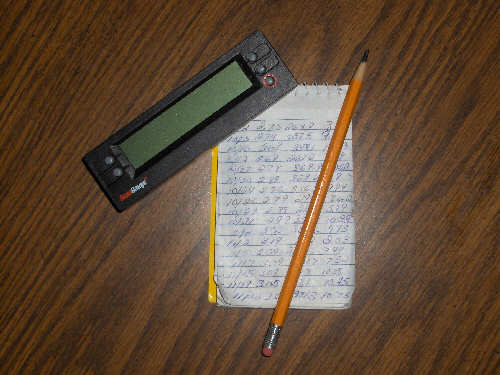This post is part of a series on basic hypermiling techniques, intended to expound upon a more basic description in order to make them more accessible as well as put them in the context of safety and practicality.
Lets face it, this is about as basic as it gets. You’re not going to get better gas mileage if you have no idea what kind of mileage you are currently getting. This task is the first step to improving your gas mileage.
So, how do you track your mileage? Its quite easy, just follow this formula:
Miles traveled / gallons used
This gives you your miles per gallon or mpg.
One thing you must always do is fill your tank completely to ensure accuracy. I recommend filling the tank until it shuts off the first time. Filling past that point can introduce more variation in tank to tank gas mileage measurements.
Logging your information can be done in a number of ways. Many people like to carry a small notebook in their car that they can log their miles and gallons. Some get fancy and use a PDA. Still, others may simply write their mileage down on a receipt and log their info into a spreadsheet or ecomodder’s fuel log once they get home. They are all means to an end. Dating your entries is very helpful as you can see your mileage go up in the summer and down in the winter. It also may help to add notes to your log so you can remember when you did something like pump up your tires more, or track driving conditions if that week the traffic or weather was abnormally bad.

There are some nice benefits to tracking your mileage. Number one is probably being able to monitor driving technique changes. Changing driving technique can alter fuel economy drastically (+/- 50%) for the good or for the worse. Logging mileage also helps with maintenance. If you fill up and see your mileage is oddly low, you know something is wrong with the car and you can have it looked at right away. This may prevent you from being stranded somewhere which is a nice thought, especially in winter. Even if you do nothing else but log your mileage, you are at least going to be somewhat aware of how your driving and environment is effecting your gas mileage.
Is there something more you can do for immediate mileage feedback? Well, yes there is. For those wanting to dive right in, you can purchase a scangauge (or similar device) if your car is a 1996 or newer vehicle. The scangauge plugs into your car’s computer port and spits out all sorts of useful information that can lead to much better fuel economy. For those with an older vehicle you don’t have it quite as easy. But, if you visit our forum we can point you in the right direction. Instant feedback from a mileage device is almost invaluable for tweaking driving style.
So, the quick and easy of it is:
- Track your miles divided by gallons.
- Find a way to log that works best for you.
- If you can, get a scangauge. It is an amazing tool.
If you liked this post, sign up for our RSS Feed for automatic updates.
Popularity: 5% [?]





Comments on this entry are closed.